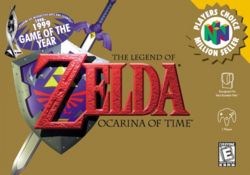Difference between revisions of "The Legend of Zelda: Ocarina of Time"
| Line 13: | Line 13: | ||
| rating= ESRB: E | | rating= ESRB: E | ||
|}} | |}} | ||
| + | |||
| + | ''To see the item, please see [[Ocarina of Time]].'' | ||
'''The Legend of Zelda: Ocarina of Time''' was The Legend of Zelda's jump to 3D. It's consistently called one of the best games for the [[Nintendo 64]] and is often called one of the best games of all time. | '''The Legend of Zelda: Ocarina of Time''' was The Legend of Zelda's jump to 3D. It's consistently called one of the best games for the [[Nintendo 64]] and is often called one of the best games of all time. | ||
Revision as of 11:01, 26 March 2007

| |
| The Legend of Zelda: Ocarina of Time | |
| Full Title | The Legend of Zelda: Ocarina of Time |
| Developer | Nintendo |
| Publisher | Nintendo |
| System | Nintendo 64 Virtual Console |
| Release Date | Nintendo 64 JP:JP November 21, 1998 US November 23, 1998 EU December 18, 1998 CH:November 2003 Virtual Console US February 26, 2007 JP February 27, 2007 EU February 23, 2007 |
| Genre | Adventure |
| Gallery | GH Gallery |
| Rating | ESRB: E |
To see the item, please see Ocarina of Time.
The Legend of Zelda: Ocarina of Time was The Legend of Zelda's jump to 3D. It's consistently called one of the best games for the Nintendo 64 and is often called one of the best games of all time.
Story
One day, the fairy Navi comes to Link to tell him the Great Deku Tree wants to talk to him. Once Link goes to the Great Deku tree, it tells him that he's been cursed and needs Link to go inside him and defeat the evil within. Link accepts the challenge and manages to defeat the evil. The Great Deku Tree tells Link that he is going to die and gives him one of the spiritual stones. He tells Link to find Princess Zelda and show her the stone. So, Link's epic adventure begins.
Information
Nintendo actually released three different versions of this game, excluding ports and remakes. Versions 1.0 was the gold cartridges released in 1998, Version 1.1 was the later gold cartridges, and Version 1.2 is the later gray cartridges.
Version 1.0 has a glitch that allows the player to play without the Master Sword and use any item while riding Epona. At the end of the game, Ganon's blood is red.
Version 1.1 fixed many of the bugs from Version 1.0. At the end of the game, the color of Ganon's blood changes with the color of the tunic Link wears.
In Version 1.2, Ganon's blood is green. They also changed the music in the Fire Temple because it contained an Arabic prase that translates to "I bear witness that there is no God, but Allah." This was found offensive by the Muslim community.
In the Gamecube versions of the game, the star and crescent symbol used by the Gerudoes was changed to the symbol used by the Gerudo pirates in The Legend of Zelda: Majora's Mask due to further complaints.
Legacy
Sequels
The Legend of Zelda: Ocarina of Time was followed by The Legend of Zelda: Majora's Mask. The sequel used the same basic engine, but included a unique three-day cycle as well as new items and the ability for young Link to ride Epona.
Ports and Rereleases
- In November 2003, The Legend of Zelda: Ocarina of Time was included in The Legend of Zelda: Collector's Edition promotional disk for the Nintendo Gamecube.
- In February 15, 2003 The Legend of Zelda: Ocarina of Time Master Quest was made available as a preorder bonus for The Legend of Zelda: The Wind Waker.
- The Legend of Zelda: Ocarina of Time was released on the Wii's Virtual Console in 2007.